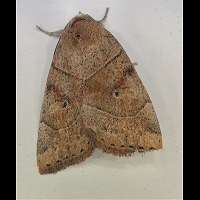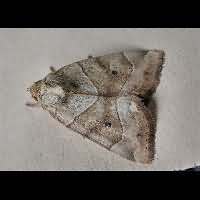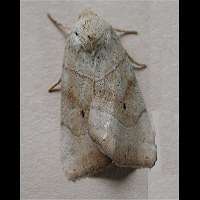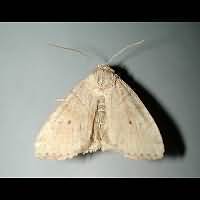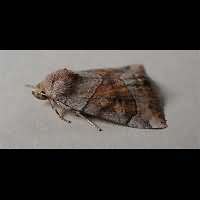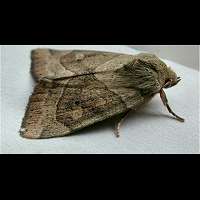Dun-bar Cosmia trapezina
The Dun-bar is a very variable moth. The basic colouring is brownish, reddish brown, greyish or greyish brown or ochreous. In the middle of the wing is a broad dark band and in it a very striking black dot. Usually it is a species easily identified by all or two of the following characteristics. The black dot, which is visible even in worn out animals, the upper line of the band which runs very stright from one side to the other side of the wing and the small, black markings near the lower edge of the wing. Every now and then however specimens appear which are quite hard to identify. The species is variable in size as well, for the wing span varies from 28 to almost 40mm.
The eggs of the Dun-bar are being laid by the end of summer. They are deposited in small groups, which are covered by scales from the female's own body. They only hatch in April of next year. The caterpillars are not only extremely kannibalistic, they will also eat the caterpillars of other moths, given the chance. Carter and Hargreaves report that they are especially hunting for the larvae of the Winter Moth. In June the caterpillars are fully grown and drop to the ground. Here they make a light cocoon between leaflitter or just below the surface. They pupate here, which may take less than 4 weeks. The caterpillar is green with characteristic black dots surrounded by a white circle. There are yellow rings between the segments. There are some lines, including a white yellowish broad dorsal line. The head is brightly green. The larvae are active during the day and during the night. It reaches a length of some 28mm and is seen on numerous trees and shrubs, including birch, oak, hawthorn and sallow.
The Dun-bar is on the wing for quite a long time: from June to October, but most animals fly in July and the beginning of August. They are easily attracted to both sugar and light. In forests they may be seen in twilight visiting ragwort. By day it is found resting on trees. Also rests on walls, posts and fences near outside lamps. A very common species over most of Europe, including the north. A common species all over the British Isles, except for Orkney and Northern Scotland where it is a local species only.
The Dun-bar is a very variable moth. The basic colouring is brownish, reddish brown, greyish or greyish brown or ochreous. In the middle of the wing is a broad dark band and in it a very striking black dot. Usually it is a species easily identified by all or two of the following characteristics. The black dot, which is visible even in worn out animals, the upper line of the band which runs very stright from one side to the other side of the wing and the small, black markings near the lower edge of the wing. Every now and then however specimens appear which are quite hard to identify. The species is variable in size as well, for the wing span varies from 28 to almost 40mm.
The eggs of the Dun-bar are being laid by the end of summer. They are deposited in small groups, which are covered by scales from the female's own body. They only hatch in April of next year. The caterpillars are not only extremely kannibalistic, they will also eat the caterpillars of other moths, given the chance. Carter and Hargreaves report that they are especially hunting for the larvae of the Winter Moth. In June the caterpillars are fully grown and drop to the ground. Here they make a light cocoon between leaflitter or just below the surface. They pupate here, which may take less than 4 weeks. The caterpillar is green with characteristic black dots surrounded by a white circle. There are yellow rings between the segments. There are some lines, including a white yellowish broad dorsal line. The head is brightly green. The larvae are active during the day and during the night. It reaches a length of some 28mm and is seen on numerous trees and shrubs, including birch, oak, hawthorn and sallow.
The Dun-bar is on the wing for quite a long time: from June to October, but most animals fly in July and the beginning of August. They are easily attracted to both sugar and light. In forests they may be seen in twilight visiting ragwort. By day it is found resting on trees. Also rests on walls, posts and fences near outside lamps. A very common species over most of Europe, including the north. A common species all over the British Isles, except for Orkney and Northern Scotland where it is a local species only.

